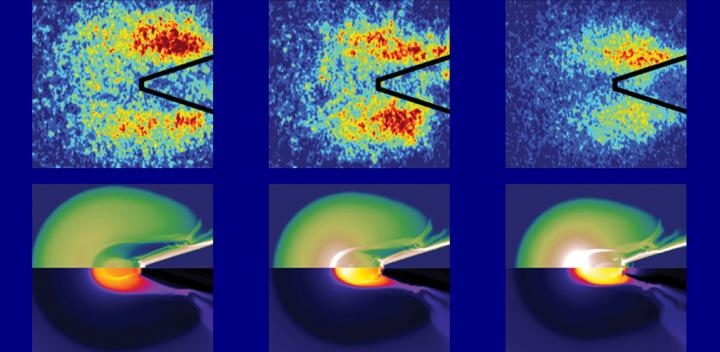
New Technique Reveals Energy Flow in Nuclear Fusion Research

Visualization of energy flow in fast ignition experiments is made possible by the use of copper tracers and a high-tech X-ray imaging system.
Credit: High Energy Density Physics Group, UC San Diego
The team, led by scientists and engineers at the University of California, San Diego and General Atomics, developed a new technique to “see” where energy is delivered during a process called fast ignition, which is an approach to initiate nuclear fusion reactions using a high-intensity laser.
Visualizing the energy flow enabled researchers to test different ways to improve energy delivery to the fuel target in their experiments. The researchers published their findings online in the Jan. 11 issue of the journal Nature Physics.
Fast ignition involves two stages to start nuclear fusion. First, hundreds of lasers compress the fusion fuel (typically a mix of deuterium and tritium contained in a spherical plastic fuel capsule) to high density. Then, a high-intensity laser delivers energy to rapidly heat (ignite) the compressed fuel. Scientists consider fast ignition a promising approach toward controlled nuclear fusion because it requires less energy than other approaches.
But in order for fast ignition to succeed, scientists need to overcome a big hurdle: how to direct energy from the high-intensity laser into the densest region of the fuel. “This has been a major research challenge since the idea of fast ignition was proposed,” said Farhat Beg, professor of mechanical and aerospace engineering and director of the Center for Energy Research at UC San Diego.
To tackle this problem, the team devised a way to see, for the first time, where energy travels when the high-intensity laser hits the fuel target. The technique relies on the use of copper tracers inside the fuel capsule. When the high-intensity laser beam is directed at the compressed fuel target, it generates high-energy electrons that hit the copper tracers and cause them to emit X-rays that scientists can image.
“Before we developed this technique, it was as if we were looking in the dark. Now, we can better understand where energy is being deposited so we can investigate new experimental designs to improve delivery of energy to the fuel,” said Christopher McGuffey, assistant project scientist in Beg's High Energy Density Physics Group at the UC San Diego Jacobs School of Engineering and co-author on the paper.
And that's what the team did. After experimenting with different fuel target designs and laser configurations, researchers eventually achieved a record high (up to 7 percent) efficiency of energy delivery from the high-intensity laser to the fuel. This result demonstrates an improvement on efficiency by about a factor of four compared to previous fast ignition experiments, researchers said.
Computer simulations also predicted an energy delivery efficiency as high as 15 percent if the experimental design was scaled up. But this prediction still needs to be tested experimentally, said Beg. “We hope this work opens the door to future attempts to improve fast ignition.”
###
The study was a collaborative effort involving researchers from UC San Diego, General Atomics, the University of Rochester, Lawrence Livermore National Laboratory, Japan's Osaka University, France's University of Bordeaux and the University of Nevada, Reno. Charlie Jarrott, the first author on the paper, conducted this research as a Ph.D. student in Beg's High Energy Density Physics Group at the UC San Diego Jacobs School of Engineering. He is now a postdoctoral research staff member at Lawrence Livermore National Laboratory.
Full paper: “Visualizing fast electron energy transport into laser-compressed high-density fast-ignition targets” published Jan. 11 in Nature Physics.
The work was supported by the US Department of Energy National Nuclear Security Agency under the National Laser User Facility programme (award # DE-NA0000854, DE-NA0002033), the OFES Fusion Science Center (grant # DE-FC02-04ER54789), an OFES ACE Fast Ignition grant (DE-FG02-95ER54839), and NNSA cooperative agreement (DE-NA0001944).












